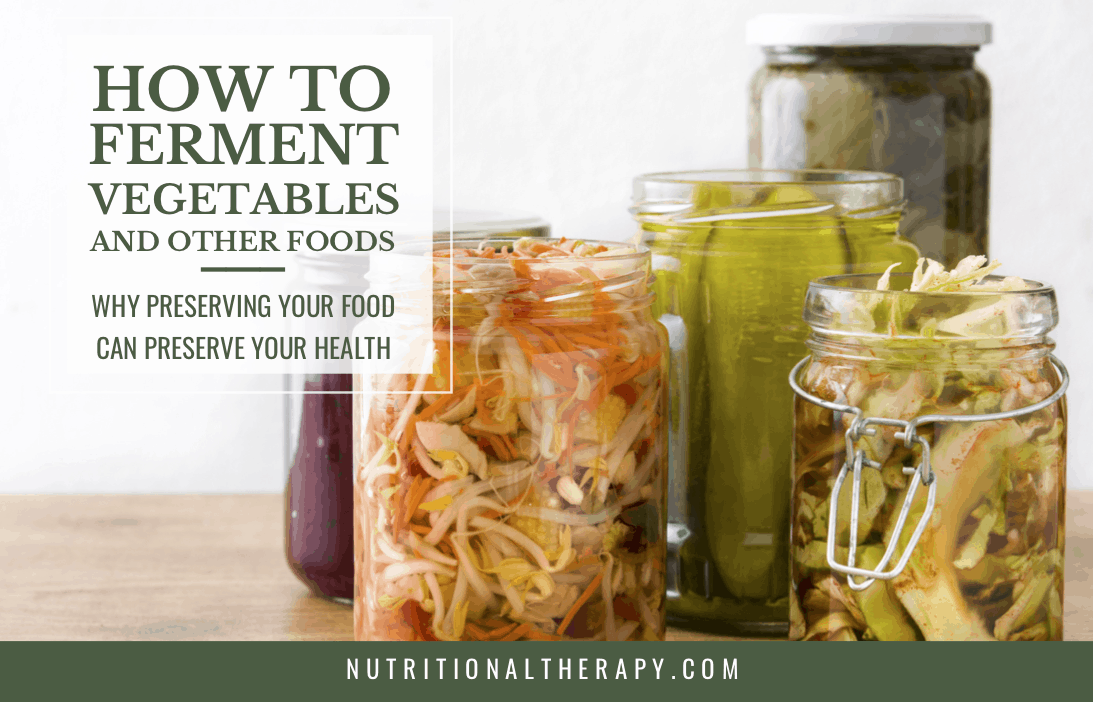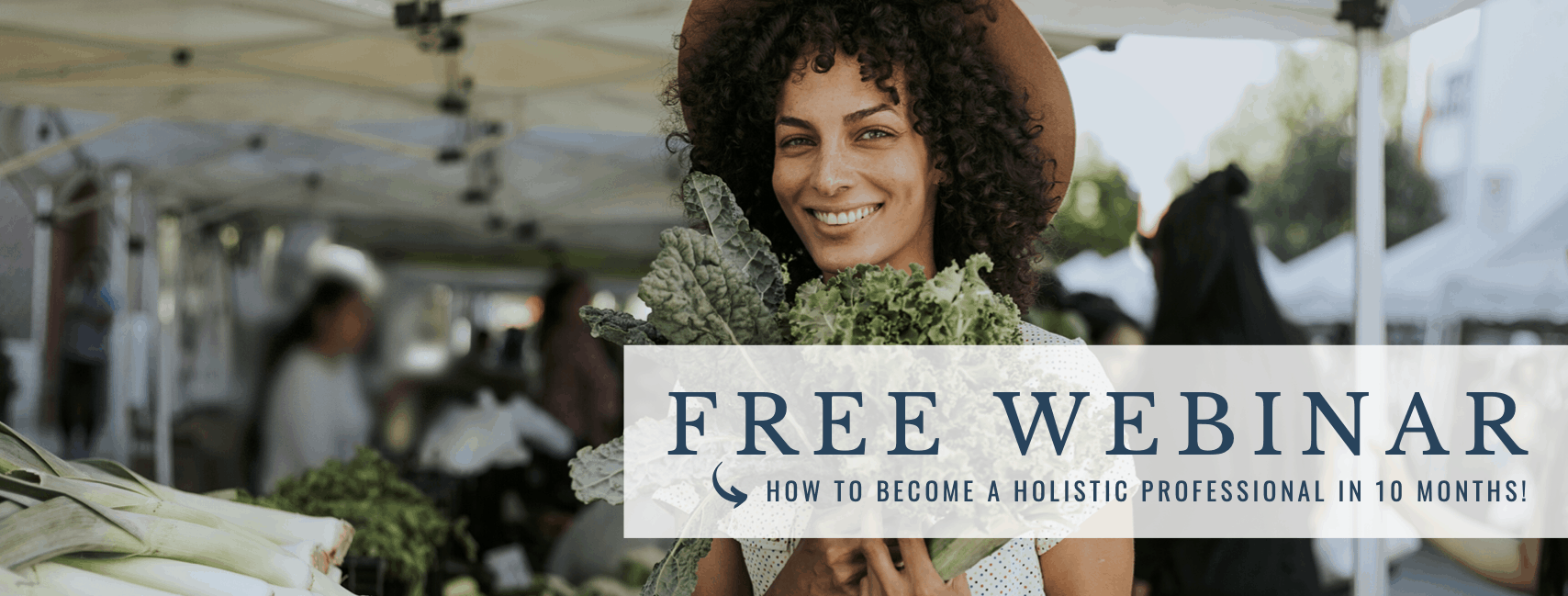Blog
How To Ferment Vegetables and Other Foods: Why Preserving Your Food Can Preserve Your Health by Yaakov Levine, NTP

We’re answering the popular question, how to ferment vegetables and other foods. This article was written by one of our graduates on the importance of cultured and fermented foods in your diet. Fermenting isn’t limited to just vegetables, the possibilities are almost are almost endless. Keep reading if you’ve been considering making your own ferments and want to learn more.
Guest post by Yaakov Levine, NTP.
History of fermentation
Cultured or fermented foods have been a nutritious part of our diets for thousands of years. In modern western society, we have replaced these healthy foods with the non-nourishing processed foods diet that make up our standard American diet (SAD). Fermenting or culturing our foods not only preserves these foods, but also will support our general health and well-being. Friendly bacteria from fermented or probiotic (meaning “for life”) foods are needed for a whole number of bodily functions. These microbes help our white blood cells fight infection, provide nutrients needed to build blood, prevent constipation and diarrhea, and prevent yeast overgrowth, as seen with Candida Albicans. Healthy bacteria in these cultured foods also are involved in production of the B vitamins, including vitamin B12.
Historically, fermented foods have supported our digestion and protected us from disease. Captain Cook’s story illuminates this fact: the famous explorer Captain Cook kept his crew healthy on long voyages by having barrels of probiotic-rich cultured cabbage (sauerkraut) available to eat. Many sailors otherwise died on these long sea voyages due to scurvy and other nutritional deficiencies. The story goes that Cook offered some leftover kraut that had been on the ship for more than two years to some Portuguese nobleman and they loved it. They carted off the last of the barrels to share with their friends. The sauerkraut still retained its nutritional value and health benefits even after all the time at sea.
In his book, Wild Fermentation: The Flavor, Nutrition, and Craft of Live-Culture Foods, author and activist Sandor Katz describes our society as “terrified of germs and obsessed with hygiene.” He illustrates this as he describes the increasing use of anti-bacterial soaps and gels by quoting Dr. Myron Genel of the AMA’s Council on Medical Affairs who offers that, “There is no evidence that they do any good and there is reason to suspect that they could contribute to the problem by helping to create antibiotic resistant bacteria.” Katz reminds us that “Your skin, your orifices, and the surfaces of your home are all covered with microorganisms that help protect you (and themselves) from potentially harmful organisms.” When we include in our meals live fermented foods and beverages, we can support the necessary diversity of the microbial cultures in our bodies. We can get individual probiotics in foods and nutritional supplements, but why not also take advantage of the microbes we live with and enlist their help to naturally ferment our foods? As Katz suggests, “Your environment becomes you, as you invite the microbial populations you share the earth with to enter your diet and your intestinal ecology.”
Fermentation is also key to unlocking the benefits of many common foods and beverages. Could you imagine our lives without chocolate, black tea and coffee? I cannot! Their many appealing flavors would not be available to enchant us without the fermentation process. Both cacao seeds and coffee beans, when harvested, have naturally presented the organisms that are needed for fermenting.
Resveratrol, an antioxidant abundant in dark chocolate, can benefit us by protecting our cells from free radical damage, support healthy levels of blood pressure, promote healthy blood vessels, slow down the aging process, and support our immune system. There are various forms of resveratrol, and studies tell us that the most beneficial forms are found in dark chocolate.
In his book The 150 Healthiest Foods on Earth: The Surprising, Unbiased Truth about What You Should Eat and Why noted author and nutritionist Jonny Bowden, PhD, includes coffee as a healthy choice of beverage. Bowden describes the health benefits of antioxidants naturally occurring in coffee. Two of the antioxidants responsible for coffee’s health benefits are chlorogenic and caffeic acids. A typical coffee drinker may ingest as much as one gram of chlorogenic acid and 500 mg of caffeic acid on an average day. Coffee’s natural fermentation process makes these constituents available.
While the fermentation process destroys much of cancer fighting antioxidant EGCG in black and oolong teas we have found that they contain another class of antioxidant, polyphenols, such as bioflavinoids, thearubigans, and theaflavins. A report in the Journal of Nutrition in 2001 described the antioxidant benefits of the black tea’s theaflavins equal to the EGCG benefits of (unfermented) green tea. The study showed that men who drank four cups of black tea a day had a reduced risk of stroke over men who only drank 2-3 cups daily.
Generally considered our first fermented beverage, mead, also known as honey wine, is a simple and delicious beverage. According to archeological studies, the collection of honey predates agriculture. Our hunter-gatherer ancestors probably produced the first mead drink by accident. Honey is nutritious, and in its natural form can act as a preservative and will inhibit microbial growth. Add some water and the miracle of fermentation will happen. The yeast and microbes naturally present in the air and water will work their magic. Add some antioxidant- rich berries and the result is a live, healthy and tasty beverage.
Years ago, as a dairy farmer, I regularly enjoyed the fresh taste and health benefits of our cow’s milk in its raw and un-homogenized form. Our community enjoyed the health benefits from the buckets of yogurt we produced from some of the raw milk not sold to the local processor. Fast forward to today, I still enjoy raw milk but now from a neighbor’s cow, and make kefir, a cultured dairy beverage for my family. We enjoy it in stocks, sauces, and my favorite way, with a bowl of just-picked berries. Straining the kefir through cheesecloth results in creamy “kefir cheese” and cultured whey to use as a “starter” for making other fermented foods and beverages. According to Donna Gates in her book The Body Ecology Diet: Recovering Your Health and Rebuilding Your Immunity, kefir, which originates from the Central Asian Caucasus Mountains of Georgia, may even have more probiotic value than yogurt. Noted author and physician Natasha Campbell-McBride MD, originally from Russia, refers to the topical use of kefir for rashes from thrush, candida and other skin fungus.
We can enjoy the same benefits as Captain Cook’s sailors with homemade sauerkraut. Making sauerkraut (cultured cabbage) requires a process called lacto-fermentation. Lacto-fermentation is a form of food preservation that employs various lactic acid bacteria to convert sugars in the food into lactic acid. The bacteria required for this food transformation are already present in raw cabbage so no special cultures are needed. Some sauerkraut producers will add starter cultures, cultured whey, or just sea salt.
Foods preserved via lacto-fermentation can last several months in airtight containers in your refrigerator. The probiotic and nutritious benefits are lost when sauerkraut is canned, since that process destroys much of the vitamin C and all of the live colon- loving cultures present in the raw sauerkraut.
In her book, Nourishing Traditions: The Cookbook that Challenges Politically Correct Nutrition and Diet Dictocrats, Sally Fallon provides some excellent instructions and background on the fermentation of vegetables and fruits, grains, nuts, seeds, fish and meat. Below is a sauerkraut variation based on Fallon’s basic recipe.
Basic Sauerkraut Recipe
Ingredients:
1 quart mason jar with plastic or spring lid
1 cabbage, medium sized (or ½ each red and green cabbage)
1 level tablespoon sea salt
4 tablespoons cultured whey (for a dairy free recipe, omit and use twice the sea salt)
1 tablespoon caraway seeds or fresh chopped dill
Directions:
- In a large bowl, mix sliced cabbage with caraway seeds or dill, salt and whey. The sea salt will help pull the juices from the cabbage and keep it crisp.
- Pound the cabbage with a wooden pounder or a meat hammer for a few minutes to release juices.
- Transfer a little at a time to the jar, pressing down firmly with the pounder. The top of the cabbage should be at least 1 inch below the top of the jar to allow for some expansion. Cover tightly and keep at room temperature for at least three days before transferring to your fridge.
Other notes: The addition of whey will support the growth of beneficial organisms that will support improved colon ecology. A great source of cultured whey is the liquid that accumulates in your yogurt containers. With or without the addition of whey, the resulting kraut will be tasty and support optimal health! The culturing timeline will vary depending on the season and climate, with faster fermenting in warmer weather. Watch for bubbling of the fluid that has risen to the top as a result of the pounding as a sure sign of fermentation. The sauerkraut may be eaten immediately, but the flavor improves with age. I try to keep mine in the fridge for at least a couple of weeks, but can’t always wait!
Along with vegetables and beverages, if grains and beans are soaked or fermented, they become more digestible and nutritious.
Up to 80 percent of the phosphorus (a vital mineral for bones and health), present in grains is locked into an unusable form as phytate. When a diet including more than small amounts of phytate is consumed, the body will bind calcium to phytic acid and form insoluble phytate complexes. The net result is that you lose calcium, and don’t absorb phosphorus. Phytic acid is present in beans, seeds, nuts and grains, especially in the bran or outer hull. Phytates are also found in tubers, and trace amounts occur in certain fruits and vegetables such as berries and green beans.
Further, research suggests that we will absorb approximately 20 percent more zinc and 60 percent more magnesium from our food when phytate is absent. Soaking and fermenting these foods reduces the level of phytates, so fermenting beans and grains allows greater access to their healthy benefits.
Here is a recipe for basic (phytate free) oatmeal, which is tasty and nutritious. The same process can be used for preparing any grain (wheat, teff, quinoa, rice and millet):
Basic Oatmeal Recipe
Ingredients:
1 cup oats, rolled or cracked (NOT the quick cooking kind, but old fashioned)
1 cup warm water
2 tablespoons whey, plain yogurt, kefir or buttermilk (try lemon juice or apple cider vinegar to make this casein-free or kosher)
1 cup water
½ teaspoon sea salt
1 tablespoon flax seeds, ground into meal (optional)
Real maple syrup (grade B) to sweeten (optional)
Touch of butter, ghee, coconut oil, cream or milk, optional, but especially good as the fats will slow down the release of sugar into the blood stream.
Directions:
- Mix the oats with warm water and whey or yogurt. Cover and leave in a warm place (NOT the refrigerator) for at least seven hours and as long as 24 hours (overnight is fine).
- In the morning, bring an additional cup of water to a boil with the sea salt. Add the soaked oats, reduce the heat, cover and simmer several minutes.
- Remove from heat, stir in optional flax seeds and let stand for a few minutes.
- Serve with the ghee, butter or cream and rapadura (raw) sugar, grade B maple syrup or local raw honey.
When making food and drink choices, it is key to look at the quality of the ingredients we purchase, preferably from a local source, and remember that it is equally important to properly prepare our foods to unlock the nutrients and properly culture and preserve them. This will result in preserved health and vitality for us all and for our planet!
Close your eyes, breathe, and imagine your bubbly, fermented and properly prepared foods and drinks entering your body, improving health and vitality along the way.
Resources:
- Wild Fermentation: The Flavor, Nutrition, and Craft of Live-Culture Foods by Sandor Ellix Katz (See the book’s Appendix for “Cultural Resources”)
- Nourishing Traditions: The Cookbook that Challenges Politically Correct Nutrition and Diet Dictocrats by Sally Fallon Morell with Mary G. Enig
- The Lost Language of Plants: The Ecological Importance of Plant Medicines for Life on Earth by Stephen Harrod Buhner
- Sacred and Herbal Healing Beers: The Secrets of Ancient Fermentation by Stephen Harrod Buhner
- The Botany of Desire: A Plant’s-Eye View of the World by Michael Pollan
The NTA is a participant in the Amazon Services LLC Associates Program, an affiliate advertising program designed to provide a means for sites to earn advertising fees by promoting and linking to Amazon. Some links may be considered affiliate links, this means that that the NTA may receive a small commission that is utilize in providing free resources to our community. Any product or resource that is promoted is trusted and approved by the NTA.

Join us for a Live Webinar with one of our Instructors and Admissions Advisors!
During this call, you’ll explore and learn:
- How to create a rewarding career in holistic nutrition that will give you the confidence and competence to replace your full-time income (whether you’re new to nutrition or or using it to enhance your current services)
- How our unmatched education and instructor support sets our NTP program apart from other nutrition programs
- How graduates are successfully using their education and the many career opportunities available to you
- If the NTP program is the right fit for you and how to move forward in financing your education

